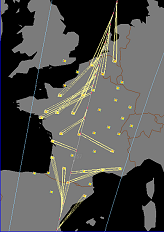
This post is an old one (last year), but I had not translated it. The satellites observing the Earth at a high resolution may be divided in two categories according to their programming mode :
- Satellites with On Demand Acquisition (SODA) :
Users ask the provider to program an image above their site. The provider collects all demands and optimises the acquisition plan so that a maximum of user requests are satisfied. The provider often charges an extra cost if the user needs an image at a precise date, and in zones where satellite image demand is high, a user is never sure to get the image he requested, unless he pays for a higher priority.
SPOT, Pleiades, Ikonos, Quickbird, Formosat-2, Rapid Eye and most radar systems are of « SODA » type.
- the Systematic Acquisition Satellites (SAS)
The image provider defines the zone to observe at the beginning or the satellite mission, and these zones are observed at each overpass of the satellite. In some cases (LANDSAT, Sentinel-2), the acquisition zones covers all lands, while on other cases (Venµs, SPOT4-(Take5)), the acquisition may only cover a few preselected sites.
Usually, SODA provide a better spatial resolution, while usually, the SAS provide a better temporal resolution. The SODA images must generally be purchased, since the resource is limited, while the SAS images are usually free of charge. There were periods when LANDSAT images were sold, but they encountered little commercial success, while their success is huge now that they are free of charge. Finally, the SODA are best suited to applications for which the acquisition date is not very important and for which a high resolution is essential, for instance urban studies or monitoring of ecological corridors, while the SAS are better suited to surfaces which quickly evolve, such as natural surfaces or farm lands, and they are best suited to automatically produce detailed land cover maps.Oppositely to the US who, thanks to LANDSAT, have been working with SAS images, in Europe, users are much more trained to use SODA images such as the ones provided by SPOT. This situation should change radically, first with LANDSAT 8, which is much easier to access in Europe than LANDSAT 5, but above all with Sentinel-2, but the adaptation to this kind of data will require a lot of work and some time. New processing methods and new applications must be developed, which was one of the aim of SPOT4 (Take5) data set.
